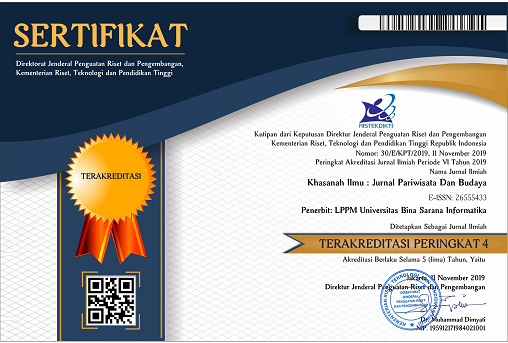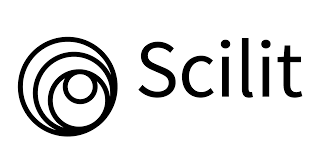Sangkuriang: Potensi Folklor dalam Pengembangan Pariwisata Kawasan Cekungan Bandung
Sari
‘Sangkuriang’ menjadi folklor yang melekat di masyarakat tanah Sunda, kehadirannya sebagai media pendidikan, hiburan, sosial dan budaya memiliki peran serta dalam promosi pariwisata. Beberapa latar tempat yang dikisahkan dalam cerita ‘Sangkuriang’ diyakini memiliki keterkaitan dengan tempat-tempat di Kawasan Cekungan Bandung yang sampai saat ini masih eksis keberadaannya. Eksplorasi tempat-tempat yang berhubungan dengan kisah romansa tragis ini perlu dilakukan guna memetakan potensi wisata dan menyusun strategi pemasaran pariwisata khususnya pada daya tarik wisata yang tersebar di Kawasan Cekungan Bandung yang berasosiasi dengan ‘Sangkuriang’. Pengeksplorasian dilakukan dengan menggunakan studi kepustakaan dan wawancara terhadap beberapa informan. Observasi lapangan dilakukan dengan tujuan untuk mengamati potensi pariwisata di kawasan tersebut. Daya tarik wisata yang muncul dalam eksplorasi menunjukkan beberapa lokasi berdasarkan geomitologi, dan toponomi dari tempat-tempat di Kawasan Cekungan Bandung. Lebih lanjut, dengan menggunakan teori storytelling dari Gamil (2017) sebagai upaya pengamanan ‘Sangkuriang’ sebagai warisan budaya takbenda dan mempromosikan daya tarik wisata yang berasosiasi dengan folklor tersebut.
Kata Kunci
Teks Lengkap:
PDFReferensi
A, R. S. R., & Setiawan, S. (2018). Pengembangan Daya Tarik Wisata Berbasis Ekowisata di Gunung Putri Lembang Kabupaten Bandung Barat. Tourism Scientific Journal, 3(2).
Abdurahman, O., & Kadarisman, D. S. (2022). Geomythology as a Geotourism Attraction, Case Study: The Sangkuriang Legend in The Bandung Highland and Its’ Surrounding Areas Based on Geological to Hermeneutics Interpretation. International Journal of Geotourism Science and Development, 2(1), 34–40. https://doi.org/10.58856/ijgsd.v2i1.17
Akgun, A. E., Zehin, C., Ayar, H., & Keskin, H. (2016). Tales of Cities: City Branding through Storytelling. Journal of Global Strategic Management, 1(10), 31–31. https://doi.org/10.20460/jgsm.20161022384
Amrullah, A., Farobie, O., Widyanto, R., Armiyanti, J., Ersis, L., Abbas, W., Jumriani, M., Bella, E., Potensi, E., Caulerpa, E., Pi, S., Dengan, A., Limbah, C., Air, K., Hapsari, J. E., Amri, C., Suyanto, A., Hidayati, J. R., Diponegoro, U., … Prihatini, N. S. (2020). Eksplorasi Potensi Sungai Citarum Sebagai Salah Satu Kawasan Diklatsar Mahacita Universitas Pendidikan Indonesia. Https://Medium.Com/, 4(3), 248–253. https://medium.com/@arifwicaksanaa/pengertian-use-case-a7e576e1b6bf%0Ahttps://doi.org/10.1016/j.biteb.2021.100642
Bachtiar, A. B., Erwina, W., & Kurniasih, N. (2023). Desain Video Literasi Informasi Kebencanaan Gempa Bumi Sesar Lembang. Jurnal Ilmiah Multidisiplin, 2(6), 142–149. https://doi.org/10.56127/jukim.v2i6.1017
Bachtiar, T., Etty, R., & Permadi, T. (2008). Topomini Kota Bandung. Bandung. Bandung Art and Culture Council.
Baruadi, M. K., & Eraku, S. (2019). The Folklore Nuances at Bantayo Poboide (Gorontalo Customhouse) as a Tourism Site in Gorontalo Regency. Proceedings of the 28th International Conference on Literature: “Literature as a Source of Wisdom,” 789–796. https://doi.org/10.24815/.v1i1.14544
Baruadi, M. K., Eraku, S., & Koem, S. (2017). The role of folk culture in the promoting tourism. A case of folklore of Otanaha Fort in Gorontalo Province. Journal of Environmental Management and Tourism, 8(6), 1279–1283. https://doi.org/10.14505/jemt.v8.6(22).15
Bassano, C., Barile, S., Piciocchi, P., Spohrer, J. C., Iandolo, F., Fisk, R., Pulizzi, J., Zhang, E. M., Ben Youssef, K., Leicht, T., Marongiu, L., Lund, N. F., Cohen, S. A., & Scarles, C. (2019). Storytelling about places: Tourism marketing in the digital age. Cities, 87(June 2018), 10–20. https://doi.org/10.1016/j.cities.2018.12.025
Brahmantyo, B., & Bachtiar, T. (2009). Wisata Bumi Cekungan Bandung. Truedee Pustaka Sejati.
Budimansyah, Dienaputra, R. D., & Sofianto, K. (2018). Banjir Dayeuhkolot: Kisah Lama dalam Cerita Baru. Jurnal Dialog Penanggulangan Bencana, 9(2), 128–141.
Cahyanto, T., Rosma, T., Zulkarnaen, D., Efendi, M., Fadillah, A., & Kulsum, Y. (2023). Notes on terrestrial orchids in Mount Burangrang Nature Reserve, West Java. AIP Conference Proceedings, 2646(April). https://doi.org/10.1063/5.0114489
Chakraborty, S. (2011). Tourism, Folklore and Community Development: In Indian Context. 741235.
Dam, M. A. ., Suparan, P., Nossin, J. ., & Voskuil, R. P. G. . (1996). A chronology for geomorphological developments in the greater Bandung area, West-Java , Indonesia. Journal of Southeast Asian Earth Sciences, 14(1/2), 101–115.
DBMTR. (2019). Cekungan Bandung Kawasan Strategis Nasional. Dinas Bina Marga dan Penataan Ruang.
Dharma, A., & Savitri, A. (2023). Analysis of Water Pollution due to Development Activities and Its Impact on the Citarum River in Indonesia. Civil Engineering and Architecture Journal, 1(3), 318–323. https://doi.org/10.37253/leader.v1i3.8302
Djelantik, S. (2023). Environmental Damage and Poverty along Citarum River. Proceedings APTIK International Conference “Environment and Poverty on Human Sensitivity: Justice, Solidarity, and Open Vision.”
Douglas, A., Hoogendoorn, G., & Richards, G. (2024). Activities as the critical link between motivation and destination choice in cultural tourism. Journal of Hospitality and Tourism Insights, 7(1), 249–271. https://doi.org/10.1108/JHTI-09-2022-0442
Edison, E., Hasanah Kurnia, M., & Indrianty, S. (2020). Strategi Pengembangan Daya Tarik Wisata Alam Sanghyang Kenit Desa Rajamandala Kulon Bandung Barat. Tourism Scientific Journal, 6(1), 96–109. https://doi.org/10.32659/tsj.v6i1.130
Edison, E., Kartika, T., & Dewi, N. (2019). Persepsi Masyarakat Terhadap Pengembangan Kawasan Wisata Di Desa Kertawangi, Cisarua Kabupaten Bandung Barat. Journal of Indonesian Tourism, Hospitality and Recreation, 2(2), 138–144. https://doi.org/10.17509/jithor.v2i2.20980
Ervina, E., Wulung, S. R. P., & Octaviany, V. (2020). Tourist Perception of Visitor Management Strategy in North Bandung Protected Area. Journal of Business on Hospitality and Tourism, 6(2), 303. https://doi.org/10.22334/jbhost.v6i2.235
Everett, S., & Parakoottathil, D. J. (2018). Transformation, meaning-making and identity creation through folklore tourism: the case of the Robin Hood Festival. Journal of Heritage Tourism, 13(1), 30–45. https://doi.org/10.1080/1743873X.2016.1251443
Fauzi, R. A. (2017). Strategi Pengembangan Daya Tarik Wisata Kebun Kina Bukit Tunggul Di Kabupaten Bandung. Jurnal Manajemen Resort dan Leisure, 14(2), 69–82. https://ejournal.upi.edu/index.php/jurel/article/view/9242
Fauziyyah, I. J. (2024). The Implementation of Ecotourism Principles in the Geger Bintang Matahari (GBM) Protected Forest At. SABA: Journal of Tourism Research, 2(1), 21–42.
Gamil, R. El. (2017). Storytelling as a Tool for Safeguarding and Marketing the Intangible Cultural Heritage (ICH): The Case of Nubia City, Egypt. Journal of Tourism Research, 18(November), 165–185.
George, B. (2016). Niche Tourism Marketing: A Case Study. January 2010. https://doi.org/10.13140/RG.2.2.32259.71205
Ghaderi, Z., Michael Hall, M. C., & Ryan, C. (2022). Overtourism, residents and Iranian rural villages: Voices from a developing country. Journal of Outdoor Recreation and Tourism, 37(July 2021), 100487. https://doi.org/10.1016/j.jort.2022.100487
Grabowski, S., Wearing, S. L., & Small, J. (2016). Time as culture: Exploring its influence in volunteer tourism. Tourism Recreation Research, 41(1), 26–36. https://doi.org/10.1080/02508281.2016.1111977
Hadian, M. S. D., Suganda, B. R., Khadijah, U. L. S., & Yuliawati, A. K. (2021). Evaluation of potential geo-tourism based on geo-diversity towards sustainable tourism at citarum river. Estudios de Economia Aplicada, 39(12), 1–14. https://doi.org/10.25115/eea.v39i12.6265
Handayani, R., Sumayadi, S., & Hartono, A. (2018). Pedoman Pengembangan Wisata Tematik Berbasis Budaya: Panduan Langkah Demi Langkah. In Deputi Bidang Pengembangan Industri dan Kelembagaan Kementerian. Kementerian Pariwisata Republik Indonesia.
Hernández-Mogollón, J. M., Pasaco-González, B. S., & Campón-Cerro, A. M. (2019). Community-based tourism from the experiential approach: A way of tourist’s participation with local communties. Journal of Tourism and Heritage Research, 2(4), 90–122.
Idris, A. M. S., Permadi, A. S. C., Kamil, A. I., Wananda, B. R., & Taufani, A. R. (2019). Citarum Harum Project: A Restoration Model of River Basin. Jurnal Perencanaan Pembangunan: The Indonesian Journal of Development Planning, 3(3), 310–324. https://doi.org/10.36574/jpp.v3i3.85
Ironside, R., & Massie, S. (2020). The folklore-centric gaze: a relational approach to landscape, folklore and tourism. Time and Mind, 00(August), 227–244. https://doi.org/10.1080/1751696X.2020.1809862
Johari, A. (2016). Representasi Mitos dan Makna pada Visual Lambang Daerah. Ritme, 2(1), 33–50.
Kartika, T., & Riana, N. (2020). Storynomics Tourism as an Effective Marketing Strategy on Tourism Destination (Case Study on Tangkuban Parahu, West Java-Indonesia). Tourism and Sustainable Development Review, 1(1), 33–40. https://doi.org/10.31098/tsdr.v1i1.8
Keputusan Presiden Republik Indonesia Nomor 12 Tahun 2012 tentang Penetapan Wilayah Sungai.
Lauder, M. R. M. T., Bachtiar, T., & Sobarna, C. (2023). Geographical Names as Indicators of the Environment: Case Study in Bandung Basin, West Java, Indonesia. In Place Naming, Identities and Geography: Critical Perspectives in a Globalizing and Standardizing World (hal. 601–618). Springer.
Light, D. (2014). Tourism and toponymy: commodifying and consuming place names. Tourism Geographies, 16(1), 141–156. https://doi.org/10.1080/14616688.2013.868031
López-Guzmán, T., Sánchez-Cañizares, S., & Pavón, V. (2011). Community - based tourism in developing countries: A case study. Tourismos: An International Multidisciplinary Journal of Tourism, 6(1), 69–84.
Lund, N. F., Cohen, S. A., & Scarles, C. (2018). The power of social media storytelling in destination branding. Journal of Destination Marketing and Management, 8(June 2017), 271–280. https://doi.org/10.1016/j.jdmm.2017.05.003
Malhotra, N. K., & Birks, D. S. (2013). Marketing Research : An Applied Approach.
Moscardo, G. (2020). Stories and design in tourism. Annals of Tourism Research, 83(May), 102950. https://doi.org/10.1016/j.annals.2020.102950
Mossberg, L., Therkelsen, A., H. Huijbens, E., Björk, & Anna-Karin Olsson, P. (2010). Storytelling and Destination Development. Nordic Innovation Centre (NICe) project number: 08041 Authors:, December, 1–65.
Mulec, I. (2010). Promotion as a tool in sustaining the destination marketing activities. Turizam, 14(1), 13–21. https://doi.org/10.5937/turizam1001013m
Narawaty, D. (2023). A Comparison of Two Stories of People Motivated by the Rejection of the Love of Roro Jonggrang and Sangkuriang and its Implications in Narrative Text Language Learning. SCOPE: Journal of English Language Teaching, 8(1), 44. https://doi.org/10.30998/scope.v8i1.17752
Noorduyn, J. (2019). Perjalanan Bujangga Manik Menyusuri Tanah Jawa: Data Topografis dari Sumber Sunda Kuno (A. A. Barata (ed.)). Perpustakaan Nasional.
Novelli, M. (2015). Niche Tourism: Contemporary issues, trends and cases (M. Novelli (ed.); 1 ed.). Elsevier Butterworth-Heinemann. https://doi.org/10.1016/B978-0-7506-6133-1.50012-3
Peraturan Presiden Republik Indonesia nomor 45 Tahun 2018 tentang Rencana Tata Ruang Kawasan Perkotaan Cekungan Bandung.
Prasetyo, F. A. (2020). Bandung dan Pemaknaan Dago dalam Sejarah: Masa Lalu, Masa Kini. Lembaran Sejarah, 15(1), 64. https://doi.org/10.22146/lembaran-sejarah.59525
PUSGEN. (2019). Modul Sesar Lembang. Pusat Studi Gempa Nasional.
Raharjo, R. P. (2017). Kearifan Lokal Mitos Gunung Kelud dan Gunung Tangkuban Parahu.
Rahayu, L. M. (2018). Transformasi Ideologi Legenda Gunung Tangkuban Perahu dalam Drama Sangkuriang-Dayang Sumbi dan Sang Kuriang Karya Utuy Tatang Sontani. Sawerigading, 24(1), 97.
Renaldy, R., & Zakiah, A. (2020). Development Mobile Application of Bandung Tempo Doeloe based on Augmented Reality Using GPS Tracking Method. International Journal of Information Engineering and Electronic Business, 12(2), 9–14. https://doi.org/10.5815/ijieeb.2020.02.02
Rinaldi, A. R., & Yusuf, M. (2024). Folklor dan Peningkatan Pengalaman Wisata di Gunung Tangkuban Parahu. Khasanah Ilmu-Jurnal Pariwisata Dan …, 15, 18–32. https://doi.org/10.31294/khi.v15i1.16228
Rohaendi, N., Sukiyah, E., Muslim, D., & Cipta, A. (2021). Geo-Tourism Land Suitability Analysis of Citatah Karst Area in Bandung Basin Using Spatial Multi Criteria Evaluation (SMCE). Geojournal of Tourism and Geosites, 39(4), 1346–1353. https://doi.org/10.30892/gtg.394spl04-777
Sekaran, U., & Bougie, R. (2016). Research Methods for Business: A Skill-Building Approach (7 (ed.)). John Wiley & Sons Ltd.
Setiawan, H. (n.d.). Bujangga Manik dan Studi Sunda.
Seyfi, S., Hall, C. M., & Rasoolimanesh, S. M. (2020). Exploring memorable cultural tourism experiences. Journal of Heritage Tourism, 15(3), 341–357. https://doi.org/10.1080/1743873X.2019.1639717
Sholeh, M., Pranoto, P., Budiastuti, S., & Sutarno, S. (2018). Analysis of Citarum River pollution indicator using chemical, physical, and bacteriological methods. AIP Conference Proceedings, 2049. https://doi.org/10.1063/1.5082473
Sugandini, D., Effendi, M. I., Susilo, P., Suryani, W., Muafi, & Syafri, W. (2019). Revisit intention: The study of community based tourism. Quality - Access to Success, 20(173), 100–106.
Sulistyorini, H. (2018). Literary Tourism on Teaching English Drama Appreciation with a Model Project Based Learning: A Play PerformanceSangkuriang, the Legend of Tangkuban Parahu. English Language and Literature International …, 2. https://jurnal.unimus.ac.id/index.php/ELLIC/article/view/3564
Supriadi, A. (2012). Kearifan Lokal Cerita Sangkuriang: Menuju Ketahanan Bangsa. METASASTRA, 5(1), 1. https://doi.org/10.26610/metasastra.2012.v5i1.1-10
Utami, A. R. (2019). Analisis Daya Tarik Unggulan Ekowisata Dusun Bambu Bandung, Jawa Barat. Jurnal Industri Pariwisata, 2(1), 21–26. https://doi.org/10.36441/pariwisata.v2i1.27
Wessing, R. (2011). Tarumanagara: What’s in a name? Journal of Southeast Asian Studies, 42(2), 325–337. https://doi.org/10.1017/S0022463411000075
Widjaja, T., Sabana, S., & Adriati, I. (2020). Sidik W Martowidjojo’s Chinese Paintings within Postmodern Aesthetic. AESCIART: International Conference on Aesthetics and the Sciences of Art, September, 372–383. https://doi.org/10.51555/338640
Wulung, S. R. P., Adriani, Y., Brahmantyo, B., & Rosyidie, A. (2021). Geotourism in west bandung regency to promote citatah-saguling aspiring geopark. IOP Conference Series: Earth and Environmental Science, 683(1). https://doi.org/10.1088/1755-1315/683/1/012115
Xiao, Z. (2002). Anthropological Analysis About Folklore Tourism. Journal of Hubei Institute of Nationalities.
Youssef, K. Ben, Leicht, T., Marongiu, L., Ben Youssef, K., Leicht, T., & Marongiu, L. (2019). Storytelling in the context of destination marketing: an analysis of conceptualisations and impact measurement. Journal of Strategic Marketing, 27(8), 696–713. https://doi.org/10.1080/0965254X.2018.1464498
Yu, X., & Xu, H. (2019). Cultural heritage elements in tourism: A tier structure from a tripartite analytical framework. Journal of Destination Marketing and Management, 13(March), 39–50. https://doi.org/10.1016/j.jdmm.2019.05.003
DOI: https://doi.org/10.31294/khi.v16i1.23147











